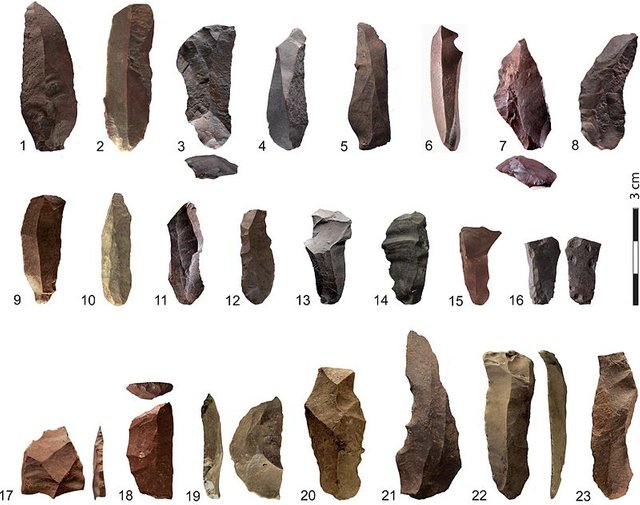The Middle Stone Age in Southern Africa : Characteristics and the artefact sequence
Characteristics of the Middle Stone Age in Southern Africa
The most important technological distinctions between the Early Stone Age (ESA) and Middle Stone Age (MSA) are the absence of large cutting tools of the ESA such as handaxes and cleavers and a general reduction in the size of flakes. The prepared core technique, which was already evident in the final stages of the Acheulian, became more widespread. The prepared striking - platform or prepared core technique is similar to the Levallois technique of Europe. The core from which the final flake is struck is carefully fashioned to ensure the desired form in the resulting flake. The flakes are struck off the core by a heavy blow (the direct percussion technique), but the finely trimmed edges of some tools suggest the use of an intermediate punch.
The South African MSA assemblages are characterized by a significantly high proportion of cores showing evidence of this preparation, which results in flakes that have faceted platforms. MSA assemblages contain large numbers of flake blanks, that is, flakes without any secondary trimming. The striking platform on the flakes and formal tools are faceted, indicating that they were struck from such prepared cores. Points and flake blades are the most typical tools of the MSA. Pointed triangular flakes with convergent sides are termed flake blades. Some researchers use the term point only for triangular pointed flakes which shows signs of secondary retouch. Points shaped by secondary trimming over one surface (unifacial points), over boths surfaces (bifacial points) and blades with secondary trimming (knives) as well as scrapers (with steep trimming or retouch on the side or end) are the common formal tool types. MSA tools could have been mounted or hafted to bone and wooden handles. Certain kinds of retouch and butt thinning suggest hafting, but no hafted MSA artefacts have yet been found. During The Howiesons Poort phase a micolithic stone tool technique was used to manufacture backed (like the blunt on a knife) and/or trucated pieces (ie trapezoids and segments) 25mm. Fine-grained materials such as silcrete, chert and opalines were used.
Sophisaticated tools form such as segments and backed by microliths present in Howiesons Poort assemblages are generally known in most parts of the world prior to 20 000 years ago. One side the blank blades is sometimes blunted in various ways to allow for a convenient handhold. Such backed pieces are seldom found except in Howiesons Poort assemblages. Regional variations is found between MSA artefact assemblages. Grindstones, wood and bone artefacts and personal ornaments such as ostrich eggshell beads are rare and known only from a few MSA sites.
The artefact sequence of the Middle Stone Age of South Africa
The excavation undertaken at Klasies River Mouth on the Tsitsikamma coast of the southern Cape were used for a basic typological description for the MSA sequence. The MSA at Klasies River Mouth was divided by Wymer (Singer & Wymer) into five chronological divisiond for stratigraphical and typological reasons. Wymer's subdivisions were arbitary. Terms MSA I, MSA II, Howiesons Poort (microlithic), MSA III and MSA IV were used. These recognised phases reflect the general similarity and continuity in the MSA artefact sequence. Even in long MSA sequences there is a lack of clear-cut technological and typological divisions. Klasies River Mouth, despite its lengthy stratigraphy, does not represent all the MSA stone artefacts patterning found at known MSA sites.
Data obtained from other cave and shelter sites with deep MSA deposits, such as Border Cave on the Natal border, Bloomplaas Cave, Die Kelders and Blombos Cave in the southern Cape, and Rose Cottage Cave (RCC) in the Free State, support the evidence from Klasies River Mouth. This basic classification has been adopted and modified by various researches for the MSA sequence.Howiesons Poort is a microlithic stone technique, which is the first occurrence of such a refined technology in the Stone Age. Apart from the type-site of Howiesons Poort, it occurs in a stratified form (as a middle phase) between other MSA assemblages at Border Cave, Rose Cottage Cave (LadyBrand , Free State) and Boomplaas Cave and Klasies River Main site in the southern Cape. Apollo XI Cave in southern Nambia and Matopo Hills of Zimbabwe. Howiesons Poort assemblages are considered to be present in eastern Lesotho at Sehonghong, Moshebi's Shelter, Melikane and Ha Soloja. Research indicates both pre- and post- Howiesons Poort MSA assemblages at most of these sites. The Howiesons Poort phase may also represent the most recent MSA levels at as number of sites with MSA occupation. This is the case at Nelson Bay Cave on the Robberg peninsula in the Southern Cape.
References:
~ Singer & Wymer (1982)
~ Deacon & Deacon (1999)
~ Hall (1996)
~ www.dailymail.co.uk : Images
Thank you for reading.
Thank you @foundation for this amazing SteemSTEM gif





Upvoted on behalf of the dropAhead Curation Team!
Your post will be Resteemed by @dropahead witness account of the dropAhead curation team!
Watch out for the #xx-votesplus tag!
By doing the above you will give us more STEEM POWER (SP) to give YOU more earnings next time.
Keep up the good work!
Most recent post: Moving #25_votes_plus to Discord
This is great post my friend.. @zest
ESA: funny acronym. I cannot make any connection with the European Space Agency this time :)
Rofl , @lemouth , you leave me speechless:)
Sure... I had only this stupid comment in mind all along the post... and I couldn't resist :p
Welcome back Zest! 😍
Thank you so much @abigail-dantes
These small cutting instruments kinda look underwhelming compared to how I imagine our wild ancestors to have been! I imagine even their fingernails to have been longer and harder than those puny stones!
Hi @alexander.alexis. I don't think a human finger nail would be strong enough to puncher animal hide or be able to cut through muscle and sinew. They might seem small, but I think your opinion might change once you feel the sharp edge of one of these primitive tools:)
Are you from RSA mate? @teamsouthafrica Cheers ;)
Hi. Yes , I am . Howzit!!!
Found your post in an info search. Loved it! Greetings.